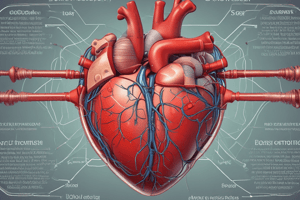Podcast
Questions and Answers
Explain the process of blood ejection during systole.
Explain the process of blood ejection during systole.
During systole, the heart contracts, creating pressure that forces blood out of the ventricles and into the arteries. This process is essential for delivering oxygen and nutrients to the body's tissues.
What is the significance of blood ejection during systole for overall cardiovascular function?
What is the significance of blood ejection during systole for overall cardiovascular function?
The ejection of blood during systole is crucial for maintaining blood flow to the body's tissues, providing oxygen and nutrients, and supporting overall cardiovascular function.
How does the ejection of blood during systole differ from the relaxation phase of the heart?
How does the ejection of blood during systole differ from the relaxation phase of the heart?
During systole, the heart contracts and ejects blood, while during the relaxation phase (diastole), the heart fills with blood. This rhythmic process ensures continuous circulation throughout the body.
Flashcards are hidden until you start studying




